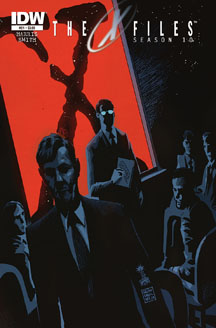This final batch of IDW’s “X-Files” Season 10 comics continues the slight downward trend since the series’ beginning but provides a kinda, sorta satisfying wrap-up – and also a cliffhanger leading into Season 11, fitting with the TV series’ approach. The final mytharc, “Elders” (Issues 21-25), has the epic feel of a mythology episode – a trick that writer Joe Harris is very good it achieving, as shown with “Believers” (1-5) and “Pilgrims” (11-15) before this. It suitably explains the powers of the Glasses Wearing Man, revealed in Issue 22 to be Gibson Praise, but doesn’t tell us why he’s doing the things he’s doing.
Put simply, Gibson – always drawn by Matthew Dow Smith in a shadow-drenched “Sin City” style emphasizing his glasses — has such god-like powers that he might as well be a god. Throughout Season 10, he has been manipulating events both specific to our characters and to humanity worldwide. Mulder is targeted by the FBI, then the DOJ, then the AG in this final arc, all because a woman revealed that he once counseled her about her alien abduction. He wasn’t authorized to use FBI funds to do this, so certainly a reprimand is in order. But when the entire justice system comes down on Mulder, it’s a frightening reminder that when you’re targeted by the government, you are toast. The downside is that we aren’t privy to the specifics of how Gibson is doing this (“god-like powers” will suffice for now) or why he is doing this (he keeps assuring Scully that it was “the only way” to get Mulder safely out of the FBI, as he had used his super-mind to examine all possible futures).
As for world events, Harris briefly shows us that Gibson is the reason why Guantanamo Bay is still open. In the real world, Gitmo is opposed by both liberty-minded people who believe prisoners should not be held unless they are charged with a crime and put on trial, and by warmongers who believe terrorism-based prisoners should be executed rather than indefinitely detained. President Obama – the commander-in-chief, who presumably has the power to back up this promise — promised to shut down Gitmo, but still has not done so eight years later, leaving the baffling question of “Why?” Harris effectively peppers in that real-world mystery by having Gibson use Gitmo as a base for his clone-growing operations and a source of hapless experimental subjects (along with the wider expanse of Cuba).
“Elders” crystalizes what an eagle-eyed reader might’ve already guessed: All of the Syndicate members in Season 10 are clones. They share “92 percent” of the genetic material of the original person. (That’s an odd number: When one considers that chimps and humans share almost 99 percent of the same DNA, someone who is 92 percent the Cigarette-Smoking Man should not look and behave identically to the CSM. But we’ll set that aside for now.) The alien-abduction victim whom Gibson brought back in Issue 21 to trigger the persecution of Mulder is also 92 percent the same. We can presume Gibson had access to the genetic material of everyone he “brought back” through his alliance with the aliens, specifically the shapeshifting Acolytes (introduced in Issue 1 but on the bench since Issue 18). Gibson’s hack of the FBI’s X-Files back in “Believers” then allowed him to program these clones with most of their original memories.

When Scully shoots Gibson in the head in Issue 25, and then he re-emerges as not just one clone but dozens of clones, it reveals an even greater level of power (as well as a lead-in to Season 11). Gibson’s most notable god-like power, though, was introduced (and then set aside) back in “Pilgrims”: He yanked Krycek out of a moment in the past, bringing him into the present. And he had done this several times. I think the ability to manipulate time might offer Harris an “out” if he wants to make Seasons 10 and 11 canonical with the 2016 TV miniseries. We’ll find out if he tries this tactic when Season 11 concludes later this month.
“Elders” may not hold up as complete package of storytelling, but it is an enjoyable read because Harris nails the voices of all the characters. I can hear William B. Davis saying the Cigarette-Smoking Man’s lines, and Don S. Williams delivering the First Elder’s dialogue, and so forth.
As for the issues leading up to the final mytharc, I’m not so fond of them. “Monica & John” (18) is the worst issue of Season 10 – and this is coming from someone who loves Doggett and Reyes. We learn what happened to the agents, who disappeared back in “Believers”: They were held in two nearby basements in South Dakota for 18 months by an Acolyte. Much like Chris Carter’s use of Reyes in the TV miniseries – where she was inexplicably the CSM’s nursemaid – “Monica & John” puts these former lead characters back into the series, which is a good thing, but does nothing with them that relates to their personalities or character growth, which is a bad thing. Both are more or less fine after escaping captivity, which is good I suppose, but also ridiculous; they should be traumatized beyond belief after 18 months of nothing but silence, darkness and three meals a day. We also don’t know why the Acolyte was holding them; in retrospect, I suppose puppet-master Gibson Praise just wanted Doggett and Reyes out of the way.
“G-23” (19-20) no doubt has its proponents, but it’s not my cup of tea. The art isn’t the problem, as it’s drawn by Tom Mandrake, who also drew the outstanding “30 Days of Night” crossover. But it’s entirely a psychedelic episode, one of those stories where it’s implied that you’ll enjoy it more if you’re smoking marijuana or dropping acid or something. In a nutshell, a government experiment with highly potent marijuana at Nevada’s Area 51 backfired in the early days of the conspiracy. We see this story through Mulder’s hallucinating mind – and Langly also imbues the weed, apparently because he likes getting high – and the punchline is that the super-weed had “aliens” in it. Among the wild moments is Mulder’s vision of Scully as “Red,” a cigarette-smoking, pantyhose-wearing femme fatale. Essentially, Harris is doing an off-kilter episode in the vein of Darin Morgan’s work or Carter’s “Post-Modern Prometheus” or “Bad Blood.” I admire the effort to mix up the tone of Season 10, but it’s just not my thing, especially as it comes on the heels of the return – and prompt return to the bench — of Doggett and Reyes.
All told, though, Harris does an admirable job on Season 10, consistently maintaining the pacing, tone and character voices from the TV series, even if Gibson Praise’s specific goals remain too much of a mystery in the end. In future flashback posts, I’ll look at the spinoff miniseries and special issues associated with Season 10, and then I’ll move into Season 11.

